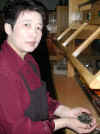| 04-05-04
"I wouldn't touch 'em with a 10-foot pole," my friend said. "How do
you know which ones are poisonous . . . and which ones ain't?"
I was telling my friend that spring mushroom season is knocking on our
door, and that this interesting activity would occupy my free moments in
the next month or so.
In so doing I was quick to point out that there are some poisonous fungi
out there, but that if one sticks to the morel species, he/she can be safe
in enjoying these culinary delights.
This part of my presentation (touting) of spring morels always includes
the fact that if a person has never eaten mushrooms (even the favored morel
species), it is a good idea to consume them a little at a time and with
other foods until you are sure they agree with your body.
I have never known anyone who became ill from eating morels, but caution
still is the word to live by.
I have always contended that while there certainly are poisonous fungi
out there, it is likely that there are far more fungi species that are
gastronomically safe. And many of them--beyond the morels--are downright
tasty.
I have always tried to impress on those seeking advice on separating
the good (non-poisonous) mushrooms from the bad (poisonous to humans) that
the safest way to go is to hunt with someone who knows good from bad until
the neophyte hunter feels proficient.
I feel advice is a good today as it ever has been.
However, last summer a boyhood chum told me about a lady who has a method
of determining whether a specific mushroom is/is not toxic.
I had to get it from the horse's mouth, so to speak, so I joined my
friend for lunch one afternoon at the Fortune House, a Chinese restaurant
near the Pyramids in Indianapolis. There I met Doreen Zhou, manager of
the restaurant.
Ed Kiewit, my high school friend, and wife Naoma, had enjoyed the cuisine
at the Fortune House for some time. He was very aware of the use of mushrooms
by Fortune House cooks, and he told Mrs. Zhou about my interest in wild
mushrooms.
Mrs. Zhou uses only commercially produced mushrooms in her kitchen,
but she had told Ed about a test the people of her homeland used to determine
the edibility of wild mushrooms.
She had been born in the eastern part of China, but had moved to the
southern part of the country as a teenager. She said conventional foods
were very scarce in the southern part of China, but the damp area produced
many species of wild mushrooms. Residents of the area depended heavily
on wild mushrooms for food, she said.
To separate edible mushrooms from those that were poisonous, the people
simply boiled the mushrooms in water with some corms (cloves) of garlic.
If the garlic turned black, the mushrooms were poisonous. If the garlic
remained light colored the mushrooms were edible. It was a test, she said,
that had come down through the ages.
When Ed (Lynn to me) told me about the wild mushroom test it was like
waving a red flag at a bull.
My first question: "Would Mrs. Zhou test some mushrooms for me?
Probably," he said, adding that he would check it out.
Mrs. Zhou would, indeed, test some mushrooms for me, and in a matter
of days I sent her a sizeable chunk of "breast meat" of a four-pound
hen-of-the-woods.
The hen, not surprisingly to me, passed the test. And she liked the
mushroom for her own culinary uses, although she emphasized that she serves
only commercial mushrooms at her restaurant. Incidentally, her mushroom
dishes are delicious, as are her other culinary creations.
Caution still is the watchword for those who hunt and consume wild mushrooms.
For example, for many years I ate the mushroom known to Hoosier "morellers"
as "spearhead" (and a few other names). It is the one with the long stem
and the tiny dark cap. The stem of this mushroom attaches to the cap above
the outer perimeter of the cap. In choice, safest species of morels, the
stem attaches at the outer perimeter of the cap.
One day several years back I came in from mushroom hunting at mid-afternoon
with a big bag of spearheads and hungry as a bear. To sate my appetite
I fried up a skillet of spearheads and ate them.
It was a great bait of fried mushrooms, but a few hours later I noticed
that I was quite nervous, somewhat like being very hungry. I have not consumed
spearheads since, although some of my morel-hunting friends swear by them.
Click on thumbnail
photo to see enlarged image.
 |
Mrs.
Zhou inspects commercial mushrooms she uses at her restaurant. |
| The
stem of favored and safest morel species joins the cap at its outer perimeter
(below). At the top the other side of the top half of this gray depicts
what morel hunters usually see. |
 |
|

